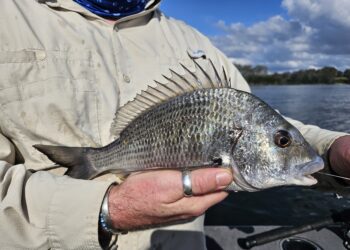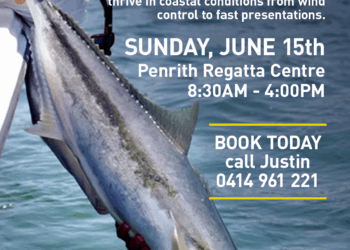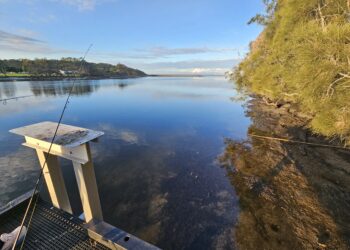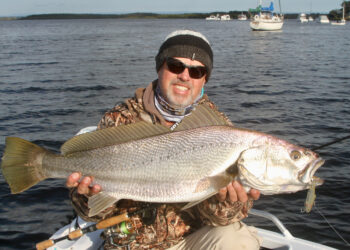COASTAL estuary systems start as freshwater streams high above the salt. This downwards flow of freshwater flows into and mixes with saltwater at some point, creating a zone of intermediate salinity known as the brackish zone before being overwhelmed by salt. This water with its intermediate salinity is somewhere between freshwater and saltwater, and is called brackish water.
To be exact, salinity is the measure of dissolved salt in water. Saltwater has on average about 35 g of dissolved salt per one litre of water i.e 3.5% salt, whereas, freshwater is classified as having 0.05% salt or less, with the main salts being sodium (Na +) and chloride (Cl −) ions).
The advantage of fishing in brackish water is that you have an opportunity to catch a variety of saltwater and freshwater species in the same area.
Brackish fish species are those that have a higher tolerance for varying levels of water salinity. Some species migrate between salt and fresh according to differing parts of their life cycles (bass being a prime example), whilst others seem to prefer the brackish zone for much of their lives. Whatever the case, prime brackish water targets include: Australian bass, estuary perch (EPs), mulloway, mangrove jack, trevally, barramundi, bream and flathead. Recognising a brackish zone without the aid of a salinity meter is usually straightforward. The most obvious guide comes in terms of the species of trees growing on the riverbank (assuming that agriculture and erosion have not seen to their demise). You’ve generally reached the brackish zone when she-oaks and reeds replace mangroves, although the salinity of water does vary according to rainfall. During periods of sustained rainfall, the greater inflow of fresh will push the brackish zone towards the mouth of the river, whilst saltwater moves higher along an estuary during times of drought. That said, it’s not hard to work out after a few exploratory trips. As an aside, stormwater water discharge points such as drainage pipes, drains and rivulets, will during rain events, discharge sufficient runoff to create micro brackish zones, which in themselves are always worth a cast.
Once you have located the brackish water the next step is to consider the types of spots where you are likely to find brackish fish. Apart from water temperature, water quality, tidal flow (or lack thereof) and structure are the main considerations.

Water Quality
Fish will only want to live in healthy water where they are in comfortable levels of salinity, temperature, and purity. High sediment levels (resulting from flood erosion), cause issues with the gills of fish, much like smoke does with human lungs. Fish will move out of this water, and even out to sea to find sediment-free water. However, colour is not a bad thing as brackish water species are quite at home (and possibly prefer) water with a slight tint of brown or green to it, probably due to the protection from predators, that is not found in clear water. Brackish water is usually discoloured as a result of natural dyes that wash in from riverside vegetation. Catching fish very clear brackish water can be problematic as they are easily scared, particularly in the shallows.
Tidal flow
The movement of the tide plays a huge impact on where the fish will be located in brackish waters and it will largely affect when and where they feed. Therefore, it’s not usually the type of fishing that you would do on a whim. Just as “no run – no fun” applies in the lower reaches of an estuary, it also applies for most species in the brackish zone (more about that later). This can be a tricky equation to break, given that the tides are later in the higher regions and the inclusion of these spots in a tide chart are a rarity. Distance from the mouth determines tidal time differences, with those spots furthest from the mouth experiencing the greatest lag. Making the only real way to determine the difference is by being on the water and seeing for yourself, using this information to plan future trips.
Structure
The presence of structure helps draw fish in brackish water just as it does elsewhere. Typically, bridge pylons, wharves, rock bars, weirs, sand and rock bars, deep holes, submerged timber and manmade refuse (sunken vehicles and old machinery) make for great fish attracters, be it shade, shelter from current or prey habitat. A focus on fishing structure will definitely improve success.

Fishing techniques
The same techniques that work for a species in the fresh or the salt, work as well in brackish water, there’s no need to change because salinity changes. What does vary however, is the strong seasonal variation that occurs between species in brackish zones. For example, bass move into the brackish zone over the cooler months to spawn and return to the fresh during spring. Alternatively, Bream move into the brackish over the warmer months, as do mangrove jacks. School mulloway are winter targets whilst trevally and flathead appear throughout the year. That said, no fish hangs around without prey, so it is important to get an understanding of baitfish and crustacean movements throughout the year … observation and a record of trips is essential!
Australian Bass / Estuary Perch
Here on the mid-north coast of NSW, estuary perch are an enigmatic fish and I don’t know that their presence is widely known. Whilst they are far less common than in the cooler regions, they are here and they can be targeted if you are tuned in to their movements. The two species are kissing cousins and you’ll probably encounter hybrids during searches for EPs, particularly if you target them during winter when the bass move into brackish water to spawn. I fish for EP’s as I do for bass, although they have a preference for smaller lures which generally require the use of a light spin outfit in order to cast accurately at snags. These tiny lures can be cast on very small bait casters if you are willing to get a little too close to the snags in order to maximise accuracy. Making baitcasting a catch-22 situation.
Small diving crank baits and 2-2.5” soft plastics are ideal for these fish. In reality the use of Bream lures, tight against snags and shady pockets (ideally both), should result in a hit from an EP if they are actively feeding. Be warned however, if a section of river gets pressured over consecutive days, EPs can shut down for a week.
Whilst sexually mature female Australian bass can produce thousands of eggs, their reproduction is complex. Not only do they need cool water to stimulate spawning (possibly as low as 9˚C), as well as specific salinities (8–12 parts per thousand). However, juvenile Bass suffer in water less than 12˚C, so it’s a tricky balance, although I imagine that the juveniles swim further downstream in search of warmer water.
Therefore, it becomes obvious that anglers should take extra care of any winter bass they encounter and perhaps extra care when a big, fat, rowed up female is caught. Netting these girls and dehooking them quickly for immediate release is how I deal with a bass I encountered during an EP trip. What we don’t want is premature egg release and/or loss of sperm.

Mulloway
Mulloway are a year-round proposition in brackish zones, although I personally catch more during the colder months. They get themselves surprisingly high up into brackish water and at times, school at the brackish/freshwater boundaries. To find schools of school mulloway, stealthy soundings of deeper holes is how it’s done. Never, ever have an outboard running, or make lots of noise if you want to target these silver beauties as they are very sensitive to noise. Early, late and nocturnal trips are the go as I think that a single passing outboard is sufficient to shut them down. So, avoid boat traffic if possible … which is much easier in brackish zones than it is in the lower regions of an estuary.
Soft plastics and vibes are the go-to lures for mulloway, with soft vibes (Berkley Shimma Shrimps and Forktails, Samaki Vibeliciuos and Zerek Fish Traps in smaller sizes) being the most productive in many situations. However, at $15+ a pop, and given the amount of timber and rock that exists in many locations, I start with a soft plastic Paddle Tail (Berkeley, TT ZMans) rigged on a 1/8th-1/4oz jig head. So much cheaper if you aren’t carrying a lure-retriever.
By carrying three outfits I can cover most situations: a light spin outfit rigged with 8lb braid and 6lb leader, a medium outfit rigged with 12lb braid and 10lb leader and a 20-30lb outfit in the event that big or nasty fish are encountered.
Mangrove Jack
Speaking of nasty fish, mangrove jacks are very, very nasty fish as we know. Once hooked you have 2-3 secs to turn its head away from the nasty, line severing cover it will invariably be rocketing towards. Do this and your halfway there, as long as they can’t get to further cover that’s between you and them. Yes, nasty creatures!
I prefer to target jacks on a low tide with diving hardbodies, both shallow and deep divers depending on the depth at which cover is located. My favourite lure is the Atomic Hardz Slim Twitcher (95 and 110mm) in gold, Daiwa’s Steez Current Master in gold and red and the Atomic Hardz Shiner. There’s plenty more, that’s just what I use … and buy two. You might lose a few shallow diving.
Heavier gear is required, with 15kg braid and leader providing sufficient grunt in most cases, although any fish over 50cm takes lots of muscle and you’ll still lose a few. Bait cast gear shines when Jack fishing: being accurate, sensitive and satisfying to use.
Soft plastics are also deadly on Jacks, either rigged on a jig head or weedless, although I reckon that I do myself a disfavour at times with weedless SP’s because of their ability to be worked through the back of a snag without hooking on the timber. But you won’t catch one unless you hook on. Zman 3” Swimmerz in red are the absolute standout for me. Jacks love them!

Trevally
Whilst not the heart-stoppers of the tropical north, juvenile trevally (GT, brassy and big eyes) are really good fun to catch on light gear. Typically, they form small packs and are most visible when feeding on surface bait or when feeding along shallow edges.
Small surface lures (poppers and walk the dog styles) are deadly and when used on 3-4kg braid, a heap of fun.
Tropical Regions
Brackish water at the top of tropical creeks in the north of the country are worth a mention on their own due to the mix of fantastic species found there. Barramundi, mangrove jack, tarpon and even saratoga in parts.
All the usual lure styles work here, particularly if the surface is clear of floating vegetation, in which case spinnerbaits tricked up with a SP or with weedlessly rigged SP’s make for easier fishing.
In closing, the brackish zones of our estuaries are well worth fishing. They are generally much quieter than the salt areas found closer to the ocean and they provide unique fishing opportunities. Check them out!


















